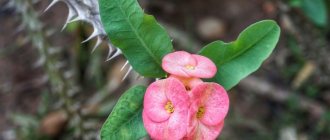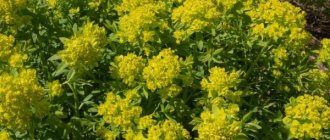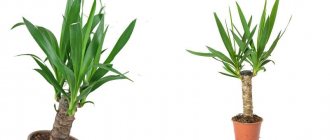Description
Garden spurge belongs to a large genus, which includes about two thousand plant species, which, in turn, belong to the Euphorbiaceae family.
The huge species diversity includes both annual and biennial plants, as well as perennial plants. Among the many euphorbias there are highly ornamental and weedy species that gardeners have great difficulty removing from their plots.
For the most part, representatives of the genus are found in African territories, but about 20 species are perfectly adapted to the harsh realities of the Russian climate.
Unfortunately, precisely because of the species diversity, it will not be possible to give a general description of milkweeds , since the plants have strong differences in stem height, leaf shape and bush structure.
But all milkweeds have one thing in common: milky sap.
For people who are allergic to latex, contact with the milky juice is strictly prohibited. The fact is that the juice contains rubber - a natural raw material for the production of latex.
You need to be very careful when working with milkweed: a couple of drops of juice on the skin can cause itching, redness and even ulcers.
If it gets into the eyes, it leads to partial loss of vision and severe burns to the cornea. The juice that reaches the stomach causes severe vomiting , diarrhea, and increased body temperature.
When they bloom, milkweeds produce attractive, brightly colored petals that are mistaken for flowers. But these are not petals, but leaf plates that are designed to attract insects to pollinate the flower itself, which is rather inconspicuous.
Reproduction methods
Euphorbia reproduces in different ways:
- seed;
- cuttings;
- dividing the bush.
Seeds
Many varieties of euphorbia are able to reproduce by self-sowing. Plants are dioecious. To breed them, it is worth combining male and female specimens on the site. It is possible to determine the sex only during the flowering period:
- in male plants, flowers are distinguished by a more elongated and narrow shape and the presence of large pistils;
- females have a wide shape and many stamens.
Cuttings
Most types of milkweed can be propagated by cuttings. This method is usually used in late spring - early summer. To do this, perform the following steps:
- Young shoots are cut off.
- The juice is washed off with water.
- Sprinkle the sections with activated carbon powder.
- Dry the cuttings for 1–2 days in a warm room.
- Drainage and a soil mixture of peat, leaf soil and sand, taken in equal proportions, are poured into the planting boxes.
- The soil is moistened.
- Cuttings are deepened into it.
Rooted milkweed is transplanted into open ground after a month.
Expert opinion
Stanislav Pavlovich
Gardener with 17 years of experience and our expert
Ask a Question
Note! Stone-loving and scaly spurges cannot be propagated by cuttings.
Garden spurge: types, photos and names
From almost 2000 varieties, every gardener will be able to choose a plant to their liking. Among the most popular ones used for garden decoration are the following.
Multiflora or polyflorum (Euphorbia epithymoides)
The natural habitat of this species is the mountainous regions of Europe. The perennial plant in the process of development forms a beautiful rounded crown of the correct shape, which, with a bush height of 0.5 to 0.7 m, creates an attractive picture.
The basal leaves are scaly, they form a rosette; the same ones that are located on the stem, round in shape. The leaf-spreads are painted in a light yellow tone, which acquires a beautiful orange color at the time of flowering. The flowering period takes a little more than a month, occurring in May – June.
Almond (Euphorbia amygdaloides)
A fairly large perennial, whose height can reach 0.7 m. Moreover, the underground part, represented by a horizontal woody root, often coincides in size with the above-ground part.
In the first year of life, the bush produces vertically oriented shoots, which become woody over time. They are densely covered with petiolate dark green leaf plates of an elongated elliptical shape.
The apical rosette of leaves overwinters on the bush, and the next year small shoots appear from it, covered with sessile greenish-yellow leaves framing the peduncles.
Flowering occurs in April - May.
Cypress (Euphorbia cyparissias)
A low (up to 0.4 meters) variety of milkweed with erect shoots, densely covered with needle-like leaves. As it grows, it forms dense clumps.
A notable feature of the plant is its ability to re-bloom : the first wave occurs in May, the second at the beginning of autumn. When flowering it spreads a pleasant aroma.
The petals-spreads of some varieties may have a delicate pink color, but in most plants they have a purple or burgundy tint.
Marginata (Euphorbia marginata)
Grown as an annual, it is distinguished by well-branched, vertically oriented shoots, whose height can reach 0.8 m.
The shoots are densely covered with light green, fairly large (up to 4 cm in length) oval-shaped leaf plates. The arrangement of leaves can be alternate or whorled.
The bush is characterized by long flowering , which lasts from July to mid-September. At this time, the apical leaf plates of garden milkweed receive a bright white border, and the bedspreads surrounding the inflorescence turn completely white.
Myrtle leaf (Euphorbia myrsynites)
This plant is simply irreplaceable when decorating rocky areas or alpine hills. The fleshy creeping stems are not too tall, their length is only about 0.2 m. The shoots form rosettes.
On the stems there are a large number of medium-sized leaf blades of an obovate shape with a remarkable greenish-blue color.
At the top of each shoot, capitate inflorescences are formed . The leaves that form the blanket are tightly curled around the flower and vaguely resemble a rose with greenish-yellow petals.
The flowering period takes all of May and most of June, but in warm springs flowering can begin in April. The plant reproduces well by self-seeding; this must be kept in mind when planting.
Capitulata (Euphorbia capitulata)
An interesting compact variety. Prefers rocky, well-lit areas. The height of the shoots is about 0.1 m. The flowering period occurs at the end of spring, and at this time capitate spurge becomes an expressive decoration of the site.
Stone-loving (Euphorbia petrophila)
A herbaceous perennial plant whose shoots at the base become woody over time. The color of the stems has a reddish or brownish tone. The height of the shoots does not exceed 0.2 m.
Foliage from previous years leaves scar marks on the stems, which can be used to approximately determine the age of the plant.
The leaf blades have an elongated elliptical shape, about 2 cm in length, and are distinguished by the presence of a serrated edge. The color of the foliage is greenish-gray, the integument is leathery, and the leaves themselves are quite dense.
Flowering occurs at the end of May and lasts until the beginning of July. The inflorescences are wrapped in burgundy egg-shaped blankets ; they are formed by 3–5 flowers.
Swamp (Euphorbia palustris)
The color of the erect long shoots, reaching a meter in length, is noteworthy - it is burgundy.
There is a lot of foliage on the shoots; it is rich green with a noticeable light cream longitudinal vein. The flowering period occurs at the end of May, at which time the plant forms fiery yellow inflorescences.
Chin or caper (Euphorbia lathyris)
This variety has a two-year life cycle and quite impressive growth (up to 1.5 m). The plant is suitable for areas located in light shade.
In the first year of life, milkweed produces an erect shoot, distinguished by a reddish color. In the second year it forms flowers and dies after flowering. The variety reproduces well by self-sowing.
Vegetable garden (Euphorbia peplus)
Since this variety is completely undemanding to soil quality and instantly reproduces by self-sowing, it is often pulled out as a weed.
But a certain decorative quality is still inherent in the low bush. And if you monitor the growing season of the plant, and immediately remove the corollas after flowering, then garden spurge may well be present on the site.
Griffith or fire (Euphorbia griffithii)
This large (up to 0.8 m in height) plant is a striking example of highly decorative milkweed. Its vertical shoots form a rounded bush and are densely covered with elongated leaf blades with a bright longitudinal stripe on each.
During the flowering period, inflorescences with red, orange or yellow petals appear on the shoots.
Cornigera (Euphorbia cornigera)
Not too bright, but an atmospheric plant, whose bush is formed by erect shoots up to 0.8 m long. The flowering period occurs in the second half of summer.
The plant forms inflorescences of horny greenish-yellow flowers. The leaves are elongated-lanceolate, dark green, with a noticeable light stripe in the center.
Schilling's (Euphorbia schillingii)
A tall bush can reach 1 m in height and serves as an excellent background for flowering perennials without overwhelming them with its blooms.
The color of the petals is yellowish-green, but not too bright. The leaf blades are elliptical in shape, rich green in color, and are distinguished by a noticeable longitudinal stripe.
Mediterranean or sculptured (Euphorbia characias)
It is distinguished by its large bush size (up to 1.5 m), early and long flowering. During the flowering period, the bush is abundantly covered with inflorescences-tassels of light green color. The bluish-green leaves have a beautiful elongated shape.
Altai (Euphorbia altaica)
A herbaceous perennial whose height does not exceed 0.2 m. The shoots do not branch; they are divided into generative and vegetative.
The shape and size of the leaves vary: at the base of the shoot they are ovoid and medium-sized (about 3 mm), at the top of the shoot the length of the leaf can already reach 3 cm, and its shape takes on an elongated oval shape.
During the flowering period, yellow-green umbrella inflorescences with a wide bell-shaped leaf-spread appear on the tops of the shoots.
Rocky (Euphorbia rupestris)
A low bush, whose vertical shoots do not exceed a height of 0.2 m. There are few leaves on the shoots, thanks to which the openwork shape of the bush .
The leaf plates themselves are very beautiful; they constitute the main decorative value. The leaf length can reach 4 cm with a width of 1.5 cm; they are painted in a bluish tone, but have bright white veins.
Scaly (Euphorbia squamosa)
This spurge attracts attention with the correct spherical shape of the bush. The height of the plant reaches 0.4 m. Oval light green leaves and yellow inflorescences complete the picture.
The main difficulties encountered when growing crops
Gardeners rarely encounter problems when growing milkweed outdoors. But sometimes it is subject to infection by pathogenic microorganisms or attacks by pests.
Diseases
The most common diseases affecting milkweed include:
| Diseases | Signs | Means of control and prevention |
| Gray rot | Brownish spots on the leaves, increasing in size Formation of a gray coating | Treatment with systemic fungicides |
| Alternaria blight | Large dark spots on leaf blades | Spraying with biological fungicides for preventive purposes and systemic ones for therapeutic purposes |
| Viral mosaic | Mottled spots of yellowish-red hues on the leaves Spread of chlorosis along the veins | Timely treatment with insecticides |
| Powdery mildew | A fluff-like coating on the upper and lower surfaces of leaves, petioles and stems The appearance of brown spots under plaque Drying of the above-ground parts of the plant | Treatment with systemic fungicides |
| Bacteriosis | Depressed appearance Lack of flowers Weeping spots on shoots and leaves with a pungent odor | Avoiding mechanical damage to plant parts |
Pests
The list of pests that can create difficulties when growing milkweed is small:
Drying and wilting of leaves
Often the state of milkweed foliage indicates certain maintenance problems:
- If the leaves fall off, the euphorbia suffers from a lack of sunlight.
- If the leaf blades turn yellow and dry, you should check whether the plant has enough moisture and whether there are pests on it.
- If the foliage is wilting, it may be due to insect pests.
No flowering
A pale shade of leaf blades, a delay or stop in development and growth, lack of flowering - all these are the first signs of insufficient light for milkweed. Another reason why flowers do not appear on bushes is due to an excessive number of side shoots and buds. They take away the nutrients that are necessary for flowering.
Growing plants from cuttings
Euphorbia is an unpretentious crop that is easy to care for and does not cause much trouble when growing.
Plants propagate well from root or stem cuttings.
To do this, the prepared material is placed in a peat substrate. The plantings are covered with film to create a greenhouse effect and regularly sprayed with a spray bottle.
For quick rooting, you need to maintain high air humidity and keep the substrate slightly moist all the time.
Due to high humidity, the greenhouse is opened daily for ventilation to prevent mold from growing.
A sign that the cuttings can be planted in individual pots and the shelter removed will be the appearance of new shoots.
Euphorbia care
When growing crops, it is necessary to monitor the growth of the root system. Some varieties require constant replanting to provide mature plants with room to grow.
Irrigation
Consistent watering is important for milkweed. This is especially true during the first weeks after planting. Plants are watered 1 or 2 times weekly. When dry periods occur, watering is increased. The top layer of soil should be slightly moist, but the roots should not be over-watered. Due to waterlogging of the root system, the process of rotting may develop.
Important! Gardeners avoid watering with cold water. It leads to the development of fungal diseases.
Fertilizer application
One of the main fertilizers is applied during planting. Then, organic matter and mineral mixtures are added throughout the growing season. A suitable option is feeding with liquid solutions. In addition, the soil is covered with a layer of mulch.
Optimal temperature and humidity
Plants require different temperatures for different stages of growth:
- for the period of active growth of milkweed, a temperature of +15 to +25 degrees is sufficient;
- seed germination takes place at +26, +28 degrees;
- sleep phases can take place at +5, +10 degrees.
Frost-resistant varieties tolerate low temperatures. To avoid freezing, bushes of perennial varieties are additionally covered for the winter.
Most varieties are succulent species, so they do not require excessive moisture. The root system quickly rots if moisture accumulates in the soil.
Trimming
Euphorbia is prone to overgrowth, so pruning is done as needed. To maintain the compactness of the bushes, faded parts are promptly removed, and the apical and lateral shoots are also pinched.
If milkweed remains in open ground areas in winter, it should be trimmed so that sprouts about 2 centimeters high are visible above the surface.
Pests and diseases: prevention and treatment
Due to the peculiarity of the root system, the crop is prone to fungal diseases. Prevention of these conditions:
- selection of loose substrate;
- control over watering moderation;
- additional chemical treatments.
Nematodes and scale insects pose a particular danger to the crop. The fight against them includes additional treatment of bushes with chemicals or soap solutions prepared independently .
Planting and care in open ground
Many types of milkweed are completely undemanding in terms of keeping conditions and reproduce well by self-sowing. But in order for the bush to actively develop and bloom luxuriantly, it will require a simple set of care measures.
Selecting a location
In most cases, preference should be given to open, well-lit areas with loose, permeable soil. But even on poor, acidified soils, spurge will not disappear, the flowering will simply be less spectacular.
Deadlines
The optimal time for planting seedlings or rooted cuttings will be mid-May - the time when the threat of return frosts has completely passed.
Outdoor sowing of seeds
The second half of May is also suitable for sowing seeds in the ground.
To improve the germination of seeds, it is recommended to stratify them (keep them in the refrigerator for two weeks), after pre-treating the surface with fine sandpaper.
Watering mode
Euphorbia is surprisingly unpretentious; it is recommended to water it only in hot weather .
However, you should not allow the soil to dry out after planting young plants - this threatens to reduce the growth rate of the plantings.
Use in landscape design
In the wild, milkweed is found on sunny, slightly shaded rocky and mountain slopes. Therefore, when designing garden plots, perennials are planted on alpine hills, rocky areas, rockeries, mixborders, or using them to create living borders. One of the advantages of euphorbia from the point of view of landscape design is the ability to maintain a decorative appearance throughout the growing season. Many varieties surprise with the colors of their leaves until late autumn.
See also: Cleaning and storing dahlias in winter
Individual plants look impressive when planted alone. With the help of low-growing varieties, you can add multi-dimensionality and volume to flower beds. Euphorbia fringed with its lacy leaves sets off plants with bright, variegated inflorescences well.
Note! Excellent neighbors for euphorbia are miniature conifers, junipers, carrion, as well as daffodils and tulips, forget-me-nots and irises, climbing roses.
Diseases and pests
The only disease that poses a threat to milkweed is a fungus, the development of which is provoked by high soil moisture. To prevent the development of the disease, it is enough to follow the watering regime.
Dangerous pests include mealybugs and spider mites. Insecticides will help reduce insect activity.
Euphorbia - harm and benefits of the plant for the body
Euphorbia has long been known for its medicinal properties. The juice of this plant is credited with a variety of qualities: from destruction and protection against the formation of cancer cells, to neutralizing snake bites.
Since ancient times, in Russia, milkweed infusion has been used to get rid of warts and calluses, and also to lighten freckles on the face. The juice of this plant contains mineral salts, rubber, alkaloids, as well as many substances beneficial to the body.
Euphorbia in garden landscape design
Unfortunately, there are no recipes left tested by healers. It is strictly not recommended to use milkweed juice without recommendations - it is very poisonous and can cause burns, itching and irritation of the skin.
The juice should not be allowed to get into the eyes or mucous membranes, and therefore it is better for children and animals not to come into contact with milkweed. When transplanting and other procedures, you should wear protective rubberized gloves.
Sowing seeds
It is better to sow seeds in soil that has been thoroughly disinfected or baked in the oven. The mini-greenhouse should be well lit for 12-14 hours. The lack of light affects not only the timing of seedling emergence. Due to poor lighting, the stems will not be able to gain strength and, having stretched “into a thread” by 1-2 cm, will simply die.
Every day, arrange ventilation for 5 minutes, no more. You can moisten the substrate only slightly using a spray bottle. If everything is done correctly, the seeds will hatch in three weeks. And after 2 months, the seedlings can be planted for permanent residence.
How to transplant into another pot?
Caring for most plants involves transplanting the bush after some time into a larger pot.
It is usually carried out in the spring. During intensive growth, a young milkweed stem must be replanted annually. As the plant grows older, the frequency of plant replanting decreases to once every 2 years. Euphorbia is moved into a large container in the spring, at the beginning of the growing season, which is done in several steps.
- Carefully and slowly choose a pot. A clay container will be successful, but a plastic flowerpot will also be a good solution.
- It is advisable to choose a low tub. The roots of milkweed do not grow much, they have weak sucking power, so a low pot is needed.
- It is recommended to make holes in the bottom of the container to allow excess moisture to escape.
- You can remove a flower from an old flowerpot by carefully separating the edges of the soil from the pot with a knife.
- The soil from the roots must be shaken off, but not cleaned off with force, since the excess soil should separate on its own.
- The plant should be placed in a pot and sprinkled with soil mixture.
- After planting, the flower must be watered by adding fertilizer to the water.
- Large plants will appreciate adding a small amount of rotted compost to the soil mixture.
What kind of soil is needed?
Important. It is recommended to buy soil for transplanting milkweed at a flower shop. A soil mixture for succulents - cacti - works well.
You can also mix the earth with your own hands if you add in equal proportions:
- leaf soil;
- turf land;
- peat;
- sand.
To ensure air permeability of the soil, it is recommended to lay drainage at the bottom of the pot. You can create a drainage layer with foam blocks, expanded clay and pebbles.
When transplanting an old milkweed bush into a new pot, prepare a container with a diameter at least 2 cm larger than the previous one. Tall spurge can turn the pot over under its own weight, so it is recommended to place stones at the bottom of the container - this will make the flower stable.
What to do if the plant does not take root?
After replanting, the plant experiences stress and needs to adapt to new conditions. If the recovery process is delayed, then you need to establish the reason in order to know what to do next.
- The plant is hot, the soil is dry - move it to a cooler place, spray it, water regularly with warm soft water.
- Excessively wet – reduce watering.
- If the previous measures did not help, you should dig up the plant and inspect the roots.
Before planting, if the roots are not watery, have not changed color, and the root system looks healthy, you can change the soil. There may be a source of infection in the ground. Before transplanting, the roots should be treated with special means.
How to root cuttings and leaves of milkweed?
The easiest way to propagate your green pet at home is by cuttings. Be sure to give the cut stems 2-3 days to wilt slightly. Please note: cuttings must be no shorter than 10 cm! Soak the cut stems in water for 24 hours. This is done so that the milky sap drains away painlessly, and the trunk does not die from lack of moisture.
After a day, thoroughly rinse the lower part of the stem. Additionally, you can treat the base of the cut in Kornevin - this will speed up the root formation process. Root in a closed container with moistened sand for 2 weeks. The process of leaf cloning is absolutely identical to cuttings. The only difference is that the leaf is rooted directly into the ground, without an intermediate water stage.











